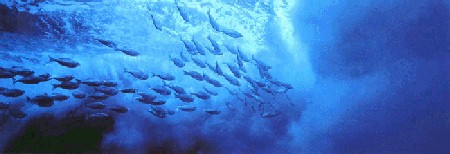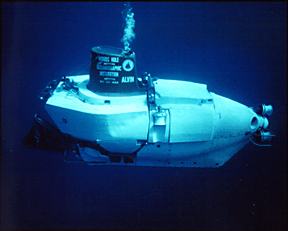


The Oceans and Man
Oceans:
 There are five oceans, the Arctic, Atlantic,
Indian, Pacific and Southern.
There are five oceans, the Arctic, Atlantic,
Indian, Pacific and Southern.
For many years only four oceans were
officially recognized, and then in the spring of 2000, the International Hydrographic
Organization established the Southern Ocean, and determined its limits.
Those limits include all water below
60 degrees south, and some of it, like the
Oceans cover 70% of the surface of the
Earth. Water is much better than air at storing heat and the oceans of the world store an
immense amount of energy, much more than the atmosphere. Since oceans are in contact with
air, heat can flow between the oceans and the atmosphere. Consequently, oceans can have a
major influence on the Earth's climate.
Like wind in air, water in the oceans
flows in a series of currents, both near the surface and also deeper down. This moves heat
all over the world, principally from areas nearer the equator to areas nearer the poles.
If this did not happen the equator would be much warmer than it is and the poles would be
much colder.
Scientists now know that ocean currents have
changed in the past. Sometimes they may change direction, slow down,  reverse or even disappear altogether. This has a major impact on climate. Changes
in ocean currents have been suggested as a possible explanation for climate changes that
occurred at the end of the last Ice Age 14,000 years ago. They may also play a significant
role if the world heats up due to global warming in the 21st century.
reverse or even disappear altogether. This has a major impact on climate. Changes
in ocean currents have been suggested as a possible explanation for climate changes that
occurred at the end of the last Ice Age 14,000 years ago. They may also play a significant
role if the world heats up due to global warming in the 21st century.
Continents drift very slowly around the world,
shifting their positions. During our lifetime, the shape of the Earth's landmasses cannot
be seen to change. This is because continental drift occurs at about the same speed as the
growth of our fingernails. However, geologists have proved that millions of years ago, the
Earth looked very different. In fact, 250 million years ago all the separate continents
that we see today were joined together as one giant landmass.
Over millions of years the changing
configuration of landmasses and oceans affects the way that heat is stored in the
atmosphere and in the oceans. This affects the Earth's climate. During the age of the
dinosaurs 100 million years ago, the Earth was much warmer than it is today, with an
average temperature perhaps as high as 25°C, and little or no snow and ice even at the
poles. Since that time, the separation of the continents has changed the flow of ocean
currents and of winds, and has isolated Antarctica at the South Pole, causing a slow
cooling down of the Earth's climate to that of today, with large ice sheets covering
Antarctica and Greenland. The size of these ice sheets has regularly grown and shrunk
during the last few million years, but this is not due to continental drift but to changes
in the Earth's orbit

Man Fights the Ocean

 In the centuries-old chronicle of
navigation, it is possible to find a great deal of evidence of the struggle of Man against
the terrible chaos of the Ocean in literature, paintings and sculpture. These are the
impassioned lines of telegraph messages and gripping descriptions of storms and
hurricanes, epic paintings by artists and stone monuments to seamen who have perished in
the Ocean. Humans have fought back against violent Ocean chaos by strengthening vessels,
finding better and more reliable means of navigation and communication and increasing the
power of engines.
In the centuries-old chronicle of
navigation, it is possible to find a great deal of evidence of the struggle of Man against
the terrible chaos of the Ocean in literature, paintings and sculpture. These are the
impassioned lines of telegraph messages and gripping descriptions of storms and
hurricanes, epic paintings by artists and stone monuments to seamen who have perished in
the Ocean. Humans have fought back against violent Ocean chaos by strengthening vessels,
finding better and more reliable means of navigation and communication and increasing the
power of engines.
The atmosphere covers our planet with a thin, oxygen-rich, life-sustaining envelope of gases. Within this envelope, weather systems form, grow to maturity and die. Below it lies one huge ocean covering over 70 per cent of the globe, with occasional continental and smaller islands breaking its watery surface. Where the oceans and the atmosphere make physical contact at the sea surface, there is a continuous exchange of momentum, water and water vapour, heat, carbon dioxide and other gases. The oceans influence the atmosphere through these exchanges and, conversely, are influenced by them. [Meteosat image copyright Eumetsat]
In addition to occupying 70% of the Earth's surface, the oceans constitute over 90% of the volume of the biosphere. They contain the evolutionary origins of biodiversity on Earth, with 75% of the major taxa of organisms being exclusively or primarily marine. The unique physical and chemical properties of our oceans render them excellent hosts for an abundance and diversity of life. However, we must first understand the biological and ecological factors controlling the marine environment before we can successfully develop global strategies for sustainable use. The biological factors controlling living marine resources collectively act as a fundamental constraint of sustainable development; as ocean policy-makers attempt to satisfy the socioeconomic aspirations of expanding human populations, they must also insure the long-term viability of resources and habitats. (Image courtesy of NOAA)
Plankton include a huge quantity of organisms, which float in different layers of the Ocean and are transported by currents. Belonging to this class are bacteria, cell-like plants (phytoplankton), some kinds of molluscs, crabs, roe and larva of fishes, larva of invertebrate bottom animals and others (zooplankton).
Nekton consist of organisms which swim in deeper waters and are capable of travelling long distances. Fishes, cephalopod molluscs, marine mammals (whales (cetaceans), seals, sea lions and walruses (pinnipeds)), sea turtles and snakes all rely on them for food. Although nekton are important to large animals, the nektonic biomass is approximately 20 times less than that of plankton.
Benthos comprise a group of organisms living near the sea floor, attached to it, dug in or living in it for shelter. Organisms living on top of the sea floor also fit into this category It contains many kinds of molluscs, crabs, worms, echinoderms and sponges. Especially beautiful are the magnificent benthos on coral reefs. The primary plants in the benthos category are multicellular seaweed (green, red, brown), microscopic one-celled plants, wrack grass, thalassia and other grasses.
There are specific communities that confine themselves to the sea surface: birds. There are 240 kinds of birds - albatrosses, frigate-birds, gannets, shearwaters, gulls and many others that live and rely heavily on the Oceanic food chain.
The Ocean provides a favourable environment
for life and the development of plant and animal organisms. All organisms living in the
Ocean are divided into three large groups: The vegetation (plants) such as seaweed and
photosynthesising bacteria, using solar energy, transform biogenic nutrients using a
process of photosynthesis. Also in this group are many bacteria that convert mineral
substances to organic substances by a process called chemosynthesis. The second group,
animals, consume plants and other animals. The Third group feeds on the remains of plants
ad other animals and also serve as food for many organisms. In the Ocean, therefore, a
certain dependency exists between its living things. Food is the primary dependency,
followed by the effects of life on Ocean productivity and then our ability to use sea life
as a resource. The diverse vegetative and animal life in the Ocean is extremely
non-uniform in its distribution. Next to areas with abundant sea life, such as zones of
upwelling, there may exist areas that have almost no living matter. These are similar to
deserts on land. On the globe there exist 63 classes of animals and 33 classes of plants,
a basic part of which live in the
Life at Depth
 The World Oceanas an environment for
vegetable and animal organisms is subdivided as such: pelagic (living in the layers of
water from the surface to the bottom) and benthic (living on the bottom of ocean) In the
pelagic class, epipelagic, mesopelagic, bathypelagic and abyssopelagic life forms live.
Below the 3,000 depth and extending to the deepest parts of the ocean is the abyssopelagic
zone. Inhabitants of the abyssopelagic zone are often colourless. The fishes and crabs
most often have no eyes but some have special flashing organs used to assist them to find
food. For distribution of benthic organisms (living on the Ocean bottom) a number of zones
have been allocated. The upper zone - littoral and sub-littoral includes places from the
tide line to depths of about 200 m; bathyal includes the range from 200 to 3,000 m;
abyssal takes in the zone from 3,000 m and ultra-abyssal takes in the zone from 6,000 m to
the floors of the deepest trenches in the Ocean. The littoral and sub-littoral are
characterised by the greatest species varieties and abundance of food. Only in this zone
does bottom vegetation develop.
The World Oceanas an environment for
vegetable and animal organisms is subdivided as such: pelagic (living in the layers of
water from the surface to the bottom) and benthic (living on the bottom of ocean) In the
pelagic class, epipelagic, mesopelagic, bathypelagic and abyssopelagic life forms live.
Below the 3,000 depth and extending to the deepest parts of the ocean is the abyssopelagic
zone. Inhabitants of the abyssopelagic zone are often colourless. The fishes and crabs
most often have no eyes but some have special flashing organs used to assist them to find
food. For distribution of benthic organisms (living on the Ocean bottom) a number of zones
have been allocated. The upper zone - littoral and sub-littoral includes places from the
tide line to depths of about 200 m; bathyal includes the range from 200 to 3,000 m;
abyssal takes in the zone from 3,000 m and ultra-abyssal takes in the zone from 6,000 m to
the floors of the deepest trenches in the Ocean. The littoral and sub-littoral are
characterised by the greatest species varieties and abundance of food. Only in this zone
does bottom vegetation develop.


Sign Guestbook View Guestbook
|